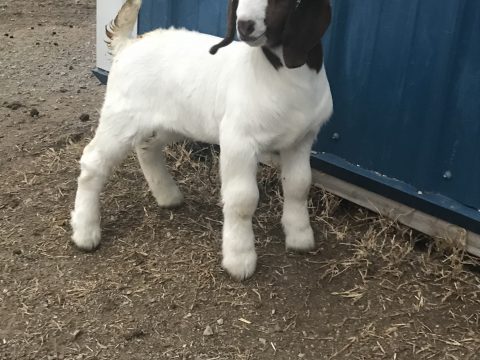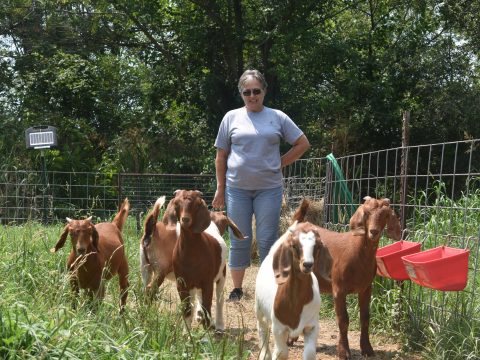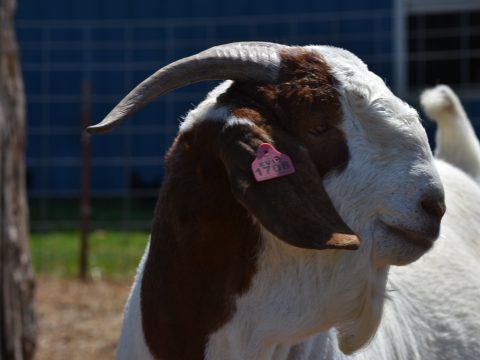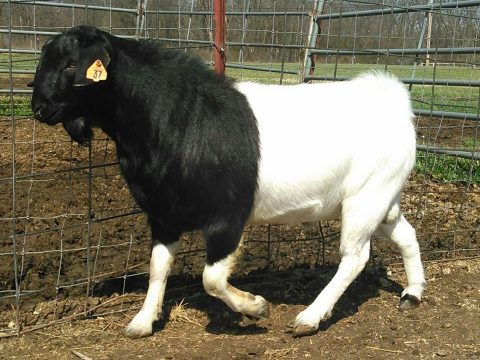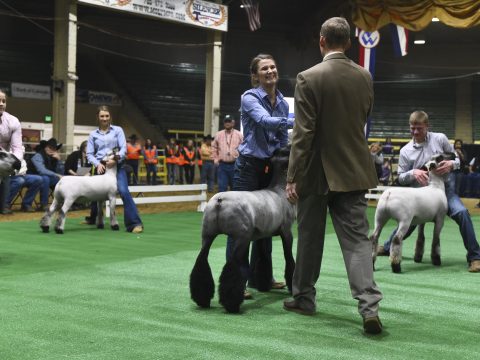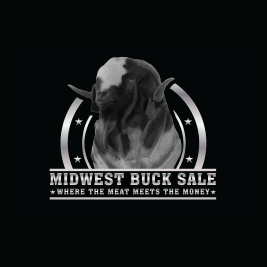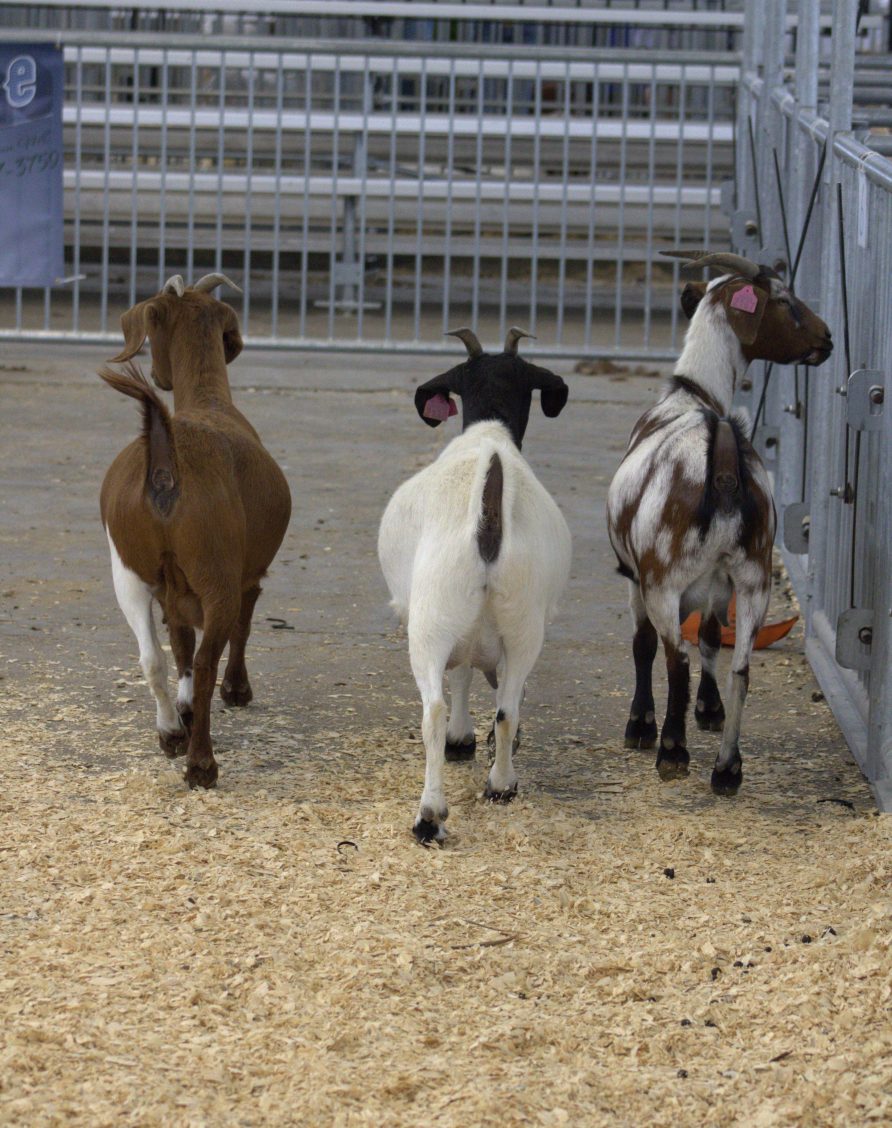
Goat Color Explained
©D.P. Sponenberg, Virginia-Maryland College of Veterinary Medicine, Virginia Tech, Blacksburg, VA 24061

The wide range of colors and patterns in goats is part of what makes them so fascinating. A goat’s color can be the “icing on the cake” of an otherwise good goat, and can be an important final touch to a goat’s appearance. Goats have great variation in color and the genetic control can be tricky, although this is more true for some breeds than for others. The huge variation in goats color can sometimes lead to some confusion. Color genetics is an intricate and complicated subject, but if it is broken down in to pieces anyone who studies the details can understand the intricacies and use them to good advantage. This might take a couple of readings, but the result should be a better understanding of why your goats produce the colors they do.
Basic Principles of Genetics
A goat’s final color results from the interaction of several independent processes, which makes control of color complicated. Interaction of the independent processes results in a wide array of final colors. A general rule is that each final color is produced by a single combination of interacting components, although a few colors are exceptions. The interactions can be understood if the basic factors are taken one at a time. The final colors can then be appreciated as various combinations of the factors working together.
Genes are responsible for the machinery of life. In goats, as in all mammals, genes occur on chromosomes. Chromosomes can be thought of as strings of genes. Chromosomes occur in pairs and an individual gets one (of the pair) from the sire and the other (of the pair) from the dam. When a goat reproduces it contributes a random half of its chromosomes (one of each pair) to its offspring. The other half of the offspring’s genetic makeup comes from the mate. Each gene takes up a specific site on a specific chromosome. This site is called a locus (plural loci), and frequently the genes are described by the locus name. Locus simply means an address for the gene: a specific place it occupies. Each member of a pair of chromosomes has identical loci, which accounts for the genes occurring in pairs.
When a gene occurs in more than one form the different forms are called alleles. The alleles of a gene all occur at the same locus, although each chromosome is limited to having only one allele at each locus. Each goat has at most a total of two different alleles per locus, since it has only two of each chromosome. Goat color varies because individual goats differ from one another in the specific allelic combinations they have at the various loci controlling the components of color.
The specific genetic makeup of a goat is called its genotype. The external appearance is called the phenotype, and may or may not completely reveal the underlying genotype. The condition of having two identical alleles at a locus is called “homozygous”. When the alleles are different, the situation is called “heterozygous”.
Alleles at a genetic locus interact in a variety of ways. Some alleles are not expressed unless both doses of the gene in an individual are the same (homozygous). These are recessive alleles (or genes, the terms are often used interchangeably). Dominant alleles, in contrast, are expressed identically whether in one dose (heterozygous) or two doses (homozygous). The dominant allele masks the expression of a recessive allele when the two are paired together. Recessive alleles are expressed as surprises when they are paired up following the mating of two individuals that carry them but do not show them (due to their being masked by dominant alleles). Dominant alleles cannot be carried along in a hidden state like this, and if a dominant allele is present it is expressed. Dominant alleles, if present, show up in each generation.
Another interaction of genes is epistasis, which is the ability of specific allelic combinations at certain loci to mask the expression of another locus. It is similar to the relationships of dominant and recessive alleles, but concerns two or more loci instead of only one. The gene that is masked by an epistatic gene (or allelic combination) is referred to as being hypostatic, while the gene or combination causing the masking is called epistatic. Hypostatic genes can pop up as surprises, much as do recessive genes.
Genetic loci can be considered as separate little biochemical factories. Each locus controls some unique aspect of the final color. Each locus can be considered to be a switching mechanism. At most loci the choice is either “situation A” or “situation B”. The choice at each locus will affect the final color, which is built step by step from all the choices at the various loci controlling color.
General considerations of color in goats
Pigments in goats consist of two main types: eumelanin and pheomelanin. These two pigments can be present or absent in varying combinations. Some genes affect only one of the two, others affect both.
Eumelanin is responsible for black-bluegrey-chocolate brown colors. On most goats eumelanin is only one shade, unless it has become bleached by the sun or changed by some other environmental (and therefore nongenetic) factor. Therefore each goat, where it has eumelanin, is all black, or all chocolate brown, and not some combination of the two. Brown eumelanin varies from very dark to very light, but the goat is one basic color overall. Eumelanin on an individual animal is always one basic color, either black, bluegrey or brown.
Pheomelanin is responsible for tan, cream, and red colors. The pheomelanic tans are extremely variable, and unlike eumelanin they frequently vary on an individual goat. Some goats have dark tan as well as pale cream pheomelanic areas. This makes accurate identification of pheomelanin tricky at times. Pheomelanin can vary from very dark to very light. At the light extreme it is nearly white. At the dark extreme it can be confused with the browns of eumelanin. Generally pheomelanic colors have a reddish tinge. This is in contrast to eumelanin, which (when brown) is usually a flatter brown with little red in it.
The position of eumelanic and pheomelanic areas determines the basic color of goats, and the classification of goat color depends on the specific pattern of pigmented areas. Unfortunately, white spotting can obscure portions of goats, making it difficult (and at times impossible) to appreciate their pigmentation type and pattern.
White regions on otherwise colored goats are not pigmented, and pigment cells are usually completely absent in white regions. This phenomenon is called “white spotting”. White spotting is superimposed over any base color, and masks it. White spotting can be thought of as painted on to a colored goat, and not the other way around. Goats can have many different patterns of white spotting, and each of these is totally independent in terms of genetic control. Even goats with very extensive white spotting do indeed have the genetic machinery, if hidden, for some base color. The hidden color genes of extensively white goats can be just as useful in a breeding program as the more obviously expressed color genes of darker goats.
The final color of the goat is due to the interaction of eumelanin (black/brown), pheomelanin (red brown/tan/cream/white), and white spotting (white). It takes practice to see every goat as some combination of these, but this approach is very helpful in figuring out what genes a goat is expressing.
The control mechanisms for final color suggest two pathways to a white goat. One of these uses the pale end of pheomelanin. Basically, first make the goat totally pheomelanic and then fade the pheomelanin to a very, very pale shade until the goat is essentially white. This is a dilution mechanism, and pigment cells are present in the white areas but are simply ineffective at producing pigment. Another general mechanism to produce a white goat is to use white spotting – in which the background color of the goat could be anything, but superimposed over this is white spotting which masks all the color with bright, pure white. White spotting can occur as multiple, independent patterns, each of which can result in a white goat. White can be a very confusing color, since just looking at a white goat does not tell much about the genetic mechanism producing the white.
A good basic approach to figuring out a goat’s color, and hopefully which genes are present, is to first ignore the white. This is obviously impossible if the goat is solid white. The goal is to figure out what pattern of tan and black areas the goat has, if any. Next, figure out the basic intensity of the tan and black. Is the tan very dark red, tan, or cream? Is the black diluted to grey or brown? Finally, add the white back on and see if the white has any specific pattern that suggests one of the genes adding white.
Color Genetics
The genetic control of color in goats is complicated, but can be broken down into components that are fairly easily understood. Confusion usually comes from not realizing that final color is the result of the interaction of several different components. Each component resides at a separate locus, and at each locus various choices occur. The sum of the choices made at each locus produces the final color.
Agouti locus
Most of the variation in goat color occurs at the Agouti locus. This locus controls the distribution of eumelanic and pheomelanic areas. The intermediate alleles at this locus result in patterns with distinctive striping patterns on the face, and this characteristic is very helpful in establishing the Agouti locus as the cause of these patterns.
The pattern of dominance at the Agouti locus is that all pheomelanic (tan) areas are expressed. When a goat has alleles for two different patterns, each is demonstrated in the final color as the tan areas of both patterns. The patterns are superimposed, with all the tan areas being expressed. This can result in some very interesting combinations, and some wonderfully appealing patterns.
Two patterns at the Agouti locus cause difficulties. One of these is the recessive “no pattern” allele, which is completely eumelanic. This is usually black, and can be thought of as “recessive black”, when considering the Agouti locus. Such goats are completely eumelanic with no stripes, so this is not intuitively assigned to the Agouti locus. At the opposite extreme is an allele “white or tan” which causes wholly tan (or white) goats. Again, stripes are missing. The “white or tan” allele is dominant to all the others, for it codes for a uniformly pheomelanic color. Whether the goat is stark white, cream, gold, or dark red (or something in between) is determined by genes not at the Agouti locus, so these color types are equivalent when considering the Agouti locus.
While the Agouti locus alleles can produce both black and white goats, there are multiple genetic mechanisms can account for both solid white and solid black goats. The specific mechanism behind a black or white goat cannot be determined by just looking at the goat. The Agouti alleles are one of many mechanisms for these colors, and are the usual mechanism in goats. Most black goats are black because they have the correct Agouti locus allele (Pygmies and black Oberhaslis are good examples). A white goat is generally white because it has the “white or tan” Agouti locus allele (Saanens and Cashmere goats are good examples).
Some of the Agouti patterns are listed in the next table. This is an incomplete list, because there are always more patterns being described and documented. Fortunately, they sort out rather nicely into a few major groups. Remember that the trick to the Agouti locus is that the tan areas are actively expressed. In the descriptions, each is described as if eumelanin is black, and pheomelanin is an obvious tan, even though these can vary considerably in individual goats.
| pattern | symbol | description |
| predominantly tan | ||
| white or tan | AWt | wholly tan, red, or white, sometimes with darker shoulder, face. |
| sable | Asb | pale legs, belly, face stripes with tan body that may have considerable eumelanic sootiness. Can be white. |
| black mask | Abm | tan with black on head, brisket, and down spine. pale stripes on head. may overlap with white or tan. Can be white. |
| tan with black trim or black periphery | ||
| caramel | Acr | tan with minor black on head and lower legs, sometimes with a black belly, and usually lacking a complete dorsal stripe typical of the blackbelly pattern. |
| bezoar | A+ | wild color: tan body, dark head with stripes, pale belly, striped legs and back. black shoulder stripe. More dark (eumelanic) in males than in females. |
| blackbelly (badgerface) | Ab | tan with black belly, backstripe, lower legs, and face stripes. This is the Oberhasli pattern. Darker males than females. |
| tan sides | Ats | similar to blackbelly but with wider backstripe and nearly black head so that tan sides are all that remains of pheomelanin. |
| black front with tan rear | ||
| san clemente | Asc | black front half, tan rear half, pale stripes on dark head, pale legs and belly. Varies from dark enough to confuse with “black and tan” to pale enough to nearly be “black mask” or “sable.” The intermediate phases are very disinctive. |
| repartida | Arp | black front half (generally lacking light eyebars), tan rear half, legs black on backs and tan on fronts, black sides of thighs. |
| tan front with black rear | ||
| peacock (cou clair) | Apk | tan front half, black rear half, dark legs, tan head with black stripes, including a distinctive one below eye and one above eye. |
| black with tan trim | ||
| toggenburg (swiss markings) | Asm | black body, dark belly, pale legs, ears, facial stripes. The Toggenburg pattern, when eumelanin is brown. |
| eyebar | Aeb | black with tan belly, rear legs tan on back and black on fronts, front legs tan on back with tan all around leg above knee and black on fronts below this. Prominent wide tan stripes on face. Can have tan on rear thighs. resembles dark “san clemente.” |
| black and tan | At | black, with tan belly, rear legs tan on back and black on fronts, front legs tan on back with tan all around leg above knee and black on fronts below this., light inside ears, light face stripes which are thin or just above eye. |
| lateral stripes | Als | as “black and tan” but darker zone on belly, reversed leg stripes (black back portions). |
| black or nearly so | ||
| mahogany | Am | fairly dark mix of black and tan hairs, dark legs, head, minor striping, usually with tan thighs. |
| red cheek | Arc | black with tan patches on cheeks, back of thighs, tops of ears. |
| no pattern | Aa | black. |
Don’t let the names on these patterns make this more difficult than it is. Some of the names are very, very poor choices, but these are the names used by most geneticists when communicating with one another. Another tactic for naming patterns is to use breed names if patterns are especially common in certain breeds. That can be confusing, too, though, since many of these patterns occur in several breeds. For example, the blackbelly pattern is the usual pattern of the Oberhasli, and so that would be a good name for it. This pattern is very, very common in a number of breeds, it is just that it is the usual one in the Oberhasli. Swiss markings, likewise, is uniform in the Toggenburg but is present in many breeds.
The point of the digression is that the names of the patterns do not imply a breed of origin—they only imply that a specific pattern is usual in a breed, probably secondary to specific selection for that pattern.
Brown locus
Another major source of variation goats is the Brown locus. This locus acts to switch eumelanin from black to brown. This means that anywhere a goat could be black, it is now brown instead. Brown varies from dark chocolate brown, light brown, or a medium brown (confusingly called “red” by Pygmy owners, but lacking the real redness of the darker tans and much more like the liver color of dogs). The Brown locus does not affect tan colors, only black, and causes any black on the goat to be brown instead. The result, on Agouti patterns, is an interplay of tan and brown instead of tan and black areas. As an example, Toggenburg goats have the “toggenburg” pattern at the Agouti locus, with the “light brown” change at the Brown locus. The result is a distinctively patterned brown goat, still easily recognizable as having an Agouti pattern. Brown combinations of Agouti patterns are common in many goats. In some breeds both a dark and light brown are present, and some also have a medium brown were also present. The brown combining with tan is especially pretty on some Agouti patterns.
The dark browns can be confusing, as these are born nearly black. They are so dark at birth that they can easily be misidentified as black instead of dark brown, but become more obvious at a few weeks of age.
The alleles at the Brown locus likely include:
| allele | symbol | description |
| dark brown | BD | dominant, a dark chocolate brown eumelanin |
| light brown | Bl | dominant, a light milk chocolate eumelanin, usually in Toggenburgs |
| wild type | B+ | black eumelanin |
| medium brown | Bb | recessive liver brown, somewhat reddish. |
Other color loci
Other loci that affect color directly are poorly documented in goats. Most species have a number of loci that act to reduce the intensity of tan areas caused by pheomelanin. These modifiers cause tan areas to be pale, and can cause the tan regions of the Agouti patterns to be yellow or cream instead of tan. Some of these modifiers are likely to be important in the production of patterns such as the Toggenburg goat, on which the pheomelanic areas are so pale as to appear to be white. These are also important in white goats based on the white or tan allele. In general (with some exceptions) the paler tans tend to dominate the darker tans and reds. In some families the switches between “dark tan” “medium tan” and “light tan or white” seem to be very simple, and may be at a single locus.
Pheomelanin can also be intensified to a deep reddish tan, or even a dark red. The shade of pheomelanin can drastically affect the overall appearance of the Agouti patterns. When pheomelanin is very dark and eumelanin is changed to brown it can be very, very difficult to appreciate that Agouti patterns are present, simply because the “tan” and “brown” areas end up being so similar in color. This is the “trick” used to produce many of the reddest breeds, for example the Rove goat of France and the Boer goat of South Africa. In those breeds the tan is taken to dark red, and the black is taken to chocolate brown. In these breeds the red is based on relatively dominant mechanisms, and so other patterns and even black goats will occasionally segregate out as recessives. This is not really all that surprising once the basics of color genetics are understood.
Moon Spots
Moon spots are those interesting tan or pale round spots that can be superimposed over any other color or pattern. They are very, very common in Nubians and in some Spanish goats. The extent of the moonspotting and the final color of these is variable. They are random, as opposed to the strict symmetrical appearance of the Agouti patterns. Most of them are distinctly round – inspiring the name. Most moonspots are fairly dark in newborns, and then become distinctly paler later. This is so pronounced that they could be missed on some kids, even though they might be very obvious later.
White and Black of Angoras
Angora goats have a few genetic variants that are rare or nonexistent in other breeds. This provides for some potential confusion when selecting Angora goats for colored fleeces. In the usual Angora, white is dominant but is not at the Agouti locus. The result is that the white of Angoras is very, very persistent in crossbreds. And, it seems to be truly white (probably from a white spotting mechanism) rather than the diluted tan that is typical of most other breeds. This is due to an allele called white angora at the White angora locus (WhWh). So, all colored goats lack this allele, and the only difficulty is encountered in whites, especially Angoras, as if this is present it masks all other color information.
Colored Angoras are rare, and most of these are either a faded red, due to the white or tan allele at Agouti, or are black. The black of most Angoras is not at the Agouti locus, and is instead a dominant allele at the Extension locus (ED). The importance of this is that this black is dominant rather than recessive, and can cover up all of the Agouti patterns. Where confusion can come in is that in some populations (usually Angoras) both the dominant Extension black and the recessive Agouit black are present. In those populations the black goats can be very confusing, although the intermediate Agouti patterns still follow all the expected rules.
important alleles for Angora goats.
| allele | symbol | description |
| white angora | WtaD | dominant white, regardless of other loci |
| wild type | Wta+ | allows color information at other loci to determine color |
| dominant black | ED | eumelanin throughout coat, regardless of Agouti alleles |
| wild type | E+ | allows expression of Agouti locus |
White Spotting
Several different patterns of white spotting occur in goats, with each under separate genetic control. That is, each pattern is controlled by a separate locus. At each of these loci the choice is “patterned” or “not patterned” (which means unspotted, unless some other locus kicks in with a pattern).
White patterns in goats, each most likely at an independent locus:
| pattern | symbol | description |
| belted | This varies from a nice ring around the barrel of the goat to a nearly white goat with colored tail and head. Also includes some with single side spots, as these are incomplete belts. Likely dominant. | |
| spotted | This is poorly characterized, with random white spots that lack the consistent appearance of belts. White on head and legs is routine. Varies from a little to a lot. Genetic control uncertain. | |
| barbari | This is a pattern of white areas on face and sides, in which small dark spots remain. It is usually symmetrical. The minimal pattern involves the head only, maximally marked goats have dark legs and backs, and speckled sides, necks, and heads. Probably dominant. | |
| flowery | This is a pattern of small white flecks throughout the coat. They are especially prominent on the sides and belly. Varies from a few flecks on belly to a very pale roan flecked goat. Probably dominant. | |
| grey | In contrast to sheep, most patterns of grey in goats are due to alleles that cause the white hairs in the coat, rather than to alleles at the Agouti locus as is the case in sheep. This includes patterns such as the “agouti grey” of the Pygmy goat. | |
| roan | Mixture of individual white hairs into the base color, usually mainly on the body and not on head and legs. Probably dominant. | |
| algarve | Ragged white and colored spots on body, usually with dark ears and eyepatches. Otherwise similar to “goulet.” likely dominant | |
| goulet | This pattern includes white ears, color over eyes, white lower face, and ragged white and colored spots over the body. Varies from very colored to very white, but the white ears are consistent. Probably dominant. | |
| nigerian | This is usually dark legs, white body with roan (rather than completely dark) spots on the white areas. Probably dominant with homozygotes very pale and lacking body spots. | |
| frosted | FrD | This is a pattern of roaning (white hairs) on the ears and muzzle, and is common on Pygmy and Nubian goats. It is present in a number of breeds. It is dominant. |
Each of these patterns can vary from minimally to extensively spotted, and this can be a source of confusion. The confusion is especially possible at the extremes of the patterns: those goats with very little white or very extensive white.
Belted goats vary from those with a small spot on the side (usually low on the side), to those with full belts, to goats that are nearly white with dark heads and dark legs.
The spotted type is more random than the belted, and is sometimes difficult to distinguish from belting. Spotted goats usually have white on the legs and head, and patches of white and color on the body. The typical spots of this pattern are smooth edged and round. Minimally spotted and minimally belted animals can be very similar, although usually “spotted” involves the head and feet.
The barbari pattern is an odd one, but does occur occasionally in the USA in several breeds. This pattern is obvious when extensive, since it provides for symmetrical white areas on the sides, neck, and head, all of which retain small flecks of color. The legs and topline seem to be the last to go white, and so extensively dalmatian goats have dark legs, tops, and speckled sides, necks, and heads. These have small spots from birth, in contrast to ticking discussed below.
Flowery is very distinctive consists of small white flecks. In minimally marked animals these are usually on the barrel. Extensively marked animals are nearly roan and very pale, though nearly always with dark legs and top of head. An entire breed of goat, the Florida Sevillana (flowery goats from Seville) is this pattern, which can be very eye-catching. It is present as a rarity in several breeds in the USA.
Roan is a relatively even mixture of white hairs into any base coat. The white and colored hairs can make up varying percentages, and so the overall effect on the color varies. Roan can modify any base color, and is most striking on darker background colors. The roaning usually spares the legs and head, which can lead to very dramatic patterns.
The algarve pattern is typical of a Portuguese breed of that name. These goats have dark ears and eyepatches, and then varying extents of variably-sized, ragged spots of white and color on the remaining body.
The goulet pattern first was documented in the Tennessee Fainting Goats of Judy Goulet. The pattern consistently has white ears, usually colored eyepatches, and usually a white lower face. The tail is white. The body pattern varies from nearly white to nearly black, but always consists of a somewhat ragged interplay of white and colored areas.
The nigerian pattern is common in Nigerian Dwarf goats in the USA. These generally have colored legs and color on the head. The body is nearly all white, but has fairly round roan spots scattered over it. In addition, it is common to have a few larger, round non-roan spots on the body and especially over the croup. Goats with one dose of the gene are usually dramatically and beautifully marked. With two doses they tend to have white bodies without the roan spots.
Frosted is common in Nubians, Pygmies, and a host of other breeds. This only affects the ears and nose, and results in these being roan or almost white. It is clearly a dominant trait, and is so routine in Pygmies and Nubians that It is reasonably rare to find a nonfrosted goat in those breeds.
Finally, some goats with white spotting develop small spots of color in the white areas. This occurs with age, usually around a year or so. This spotting is called ticking, and varies from lots to a little. When “ticks” are numerous, they merge and the effect can nearly be roan. This pattern is a sort of reverse of the “flowery” pattern, and could be confused with the barbari pattern. The key is whether the spots were present at birth or not. On extensively spotted goats the tick marks can be relatively large (up to a few inches), and very round. Ticking is probably dominant.
What color is your goat?
The final color of a goat is the result of a combination of the effects of all these different loci, each with a few choices. By taking each locus in turn it is possible to decide what is present and what is absent. If the factors that are present are dominant, it is likely that the goat is masking some recessive genes as well, and could pass those along to offspring. If the goat only shows recessive factors, then it will breed true if mated to a similar goat, or will pick up the dominant genes from the mate and those will be expressed in the kids.
First, ignore the white spotting and save it for later. A good basic sequence of questions is:
Is the goat solid black or solid white? If black, then the choice is either dominant black or recessive black. In nearly all breeds except the Angora, the answer here will be recessive black. If the goat is white, then I have a choice of extensive white spotting, Angora dominant white, or the Agouti white or tan. No one can tell these apart just by looking, so it is important to have more information about breed or parent colors.
The next question is whether or not an intermediate Agouti pattern is present. On most goats it is possible to tell which patterns are present – even if the animal is heterozygous for two different patterns. This is because the tan areas consistently show up. Generally the Agouti patterns have stripes, and so it is possible to lump these intermediate patterns as “striped goats,” and these hide very little genetic information.
Then the next question is whether the eumelanic areas black, dark brown, light brown, or medium brown. This pegs the Brown locus choices.
Are moon spots present? This is not always easy to tell, but is generally a clean “yes or no” aspect of color.
The above questions should sort through the color genes present in the goat. The only difficulty will be with black goats, white goats, extensively spotted goats, or dark red goats on whom it is difficult to decide if an intermediate Agouti pattern is hooked up with dark brown. An example is in my own herd, where a bezoar, a badgerface, and a “tan” buck, all three have dark brown eumelanin. Each buck appears dark red, but they each throw very different patterns as the Agouti and Brown variants segregate out in their kids.
After figuring out the basic color it is time to figure out the white spotting patterns that might be present. This can be difficult, especially if the goat is minimally or maximally spotted, or if multiple patterns are present. My own herd suggests that some of the combinations of belted and spotted can be very, very white! The “shwarzhal” pattern of a dark head and white body can be especially misleading, since it can hide multiple spotting patterns.
The overall summary for goat color and its genetic control is that goat color is complicated! It is made easier by taking the color one step at a time. And remember – dominant genes can hide surprises, while recessive genes cannot!
D. Phillip Sponenberg, DVM, PhD, ACT (Honorary)
Professor, Pathology and Genetics
205 Duck Pond Drive
Virginia-Maryland College of Veterinary Medicine
Virginia Tech
Blacksburg, VA 24061 USA
e-mail: dpsponen@vt.edu
telephone: 1-540-231-4805

Oder a copy today! Practical Color Genetics: CLICK HERE

Livestock Conservancy
Published with permission from Dr. Sponenberg. All Rights Reserved 2022


